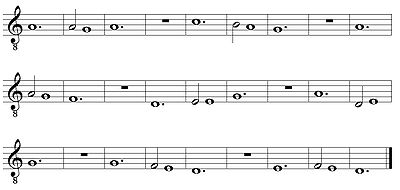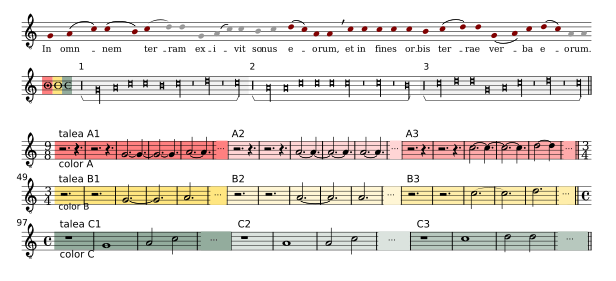- Isorhythm
-
 Isorhythmic tenor from the first part of the Kyrie of Machaut's Messe de Nostre Dame (c. 1360). A color of 28 notes is arranged with a four-note talea pattern which repeats seven times.
Isorhythmic tenor from the first part of the Kyrie of Machaut's Messe de Nostre Dame (c. 1360). A color of 28 notes is arranged with a four-note talea pattern which repeats seven times.
Isorhythm (from the Greek for "the same rhythm") is a musical technique that arranges a fixed pattern of pitches with a repeating rhythmic pattern.
Contents
Detail
It consists of an order of durations or rhythms, called a talea ("cutting", plural taleae), which is repeated within a tenor melody whose pitch content or series, called the color (repetition), varied in the number of members from the talea. The term was coined in 1904 by Friedrich Ludwig (1903–04, 223) to describe this practice in 13th century polyphonic motets, but it later became more widely applied, especially to periodic repetition or rhythmic recurrence in tenors and other parts of 14th- and early 15th-century compositions, motets in particular (Bent 2001). The technique is also found in the music of India, and in works by modern composers such as Alban Berg, Olivier Messiaen, and John Cage.[citation needed] It may be used in all voices or only a few voices. In motets, it began in the tenor voice but was then extended to higher ones.
Ars nova composer Philippe de Vitry has been credited with the invention of the technique, but it "was neither an invention of Philippe de Vitry nor his exclusive property in the early fourteenth century." The isorhythmic construction was often varied through the use of strict or free rhythmic diminution in the repetition of the color. (Hoppin 1978, p. 363)
The talea in early isorhythmic compositions was usually a short sequence of only a few notes, often corresponding to a rhythmic mode. In the course of the 14th century, taleae became much longer and more elaborate, and were used to structure much more large-scale works, where each color and talea constituted a substantial structural section of a composition measuring many bars. Around 1400, the technique of the diminution motet became common: a long tenor color was repeated several times according to different mensuration rules, making its performance faster by a fixed proportion each time. This technique was still used in the large-scale ceremonial motets by Guillaume Dufay in the mid-15th century, but his work also marks the extensive use of the more fluid polyphonic styles of the early renaissance. Dufay's motet Nuper rosarum flores, written for the inauguration of the new dome of Florence Cathedral in 1436, is regarded as the last great isorhythmic motet composition.[citation needed]
In modern usage, the term "isorhythm" is often associated with the practice of repeating two sets of parameters (such as duration and pitch) at different rates so that the values of one parameter are associated with different values of the other parameter at each repetition. The color of isorhythm may be compared with the tone row of the twelve-tone technique's fixed order of pitches and varied durations. The modern musical innovation of integral serialism sprang from a study of the 12 tone compositions of Anton Webern and the isothythmic organization within motets of Guillaume de Machaut.[citation needed]
The Isorhythmic Motet
These motets, written during the Ars Nova period of the 14th century, feature the isorhythmic principles of talea and color. Composers include Machaut and Philippe de Vitry. An example of an isorhythmic motet is Garrit Gallus/In nova fert/Neuma, which is assumed[weasel words] to be composed by Philippe de Vitry in the early to mid 14th century.
 Structural plan of the tenor of a late medieval isorhythmic motet with threefold diminution, Sub Arturo plebs by Johannes Alanus. There is a color of 24 longae (48 bars in modern notation), divided in three taleae. The color is repeated three times, each in a different mensuration. Its length is subsequently diminished by the factors of 9:6:4. The graphic shows (a) the preexisting Gregorian cantus firmus; (b) the tenor as written in mensural notation; and (c) a partial transcription of the beginnings of each of the nine taleae in modern notation.
Structural plan of the tenor of a late medieval isorhythmic motet with threefold diminution, Sub Arturo plebs by Johannes Alanus. There is a color of 24 longae (48 bars in modern notation), divided in three taleae. The color is repeated three times, each in a different mensuration. Its length is subsequently diminished by the factors of 9:6:4. The graphic shows (a) the preexisting Gregorian cantus firmus; (b) the tenor as written in mensural notation; and (c) a partial transcription of the beginnings of each of the nine taleae in modern notation.
Sources
- Bent, Margaret (2001). "Isorhythm". The New Grove Dictionary of Music and Musicians, second edition, edited by Stanley Sadie and John Tyrrell. London: Macmillan Publishers.
- Hoppin, Richard H. (1978). Medieval Music. New York: W.W. Norton & Co. ISBN 0-393-09090-6.
- Ludwig, Friedrich (1903–04). "Die 50 Beispiele Coussemaker's aus der Handschrift von Montpellier". Sammelbände der Internationalen Musik-Gesellschaft 5:177–224.
External links
Categories:
Wikimedia Foundation. 2010.
